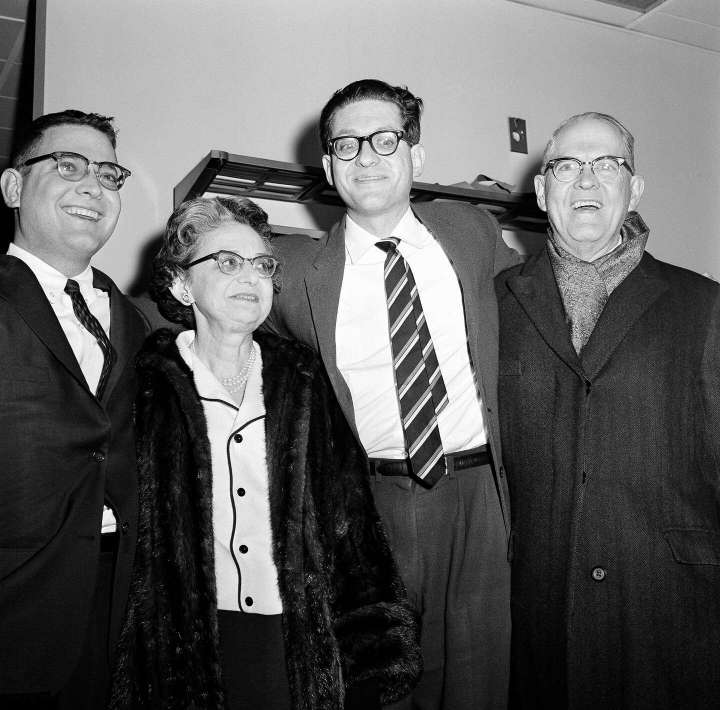Washington’s “substantial proposal” to Moscow aimed at freeing WNBA star Brittney Griner and security consultant Paul Whelan from Russian detainment follows a long history of prisoner swaps between the adversaries.
Proposal for Griner, Whelan follows history of U.S.-Russia prisoner swaps

News of the U.S. proposal follows the April exchange of former U.S. Marine Trevor Reed for Russian pilot Konstantin Yaroshenko in Turkey after months of negotiations. At the time, Bill Richardson, a retired lawmaker and diplomat who helped secure Reed’s release, told The Post that he hoped the exchange would pave the way for others and show that “both countries can, despite our enormous differences, achieve a humanitarian breakthrough.”
A swap with Griner and Whelan would be the latest in Washington’s decades-long history of trading captives with Moscow. The approach has cooled tensions and brought Americans and allies home, though critics have argued that exchanges incentivize taking Americans hostage.
“There’s a balance to be achieved with each and every arrangement,” Kirby told reporters at a news briefing. “The balance of getting folks home, but also making sure that our own national security is preserved and that … we’re not encouraging hostage-taking.”
The first major swap between the United States and the Soviet Union took place in February 1962, over the Glienicke Bridge linking East and West Germany. The Americans released convicted KGB spy Rudolf Abel in return for U.S. pilot Francis Gary Powers, whose U-2 spy plane was shot down over the Soviet Union. An American student in East German custody, Frederic Pryor, was also released as part of the deal.
However, that swap almost never happened. U.S. authorities were seeking the death penalty for Abel after his arrest in 1957. His American lawyer, James Donovan broached the idea of a prisoner exchange in arguing that Abel not be given the death penalty.
“It is possible that in the foreseeable future,” Donovan said, “an American of equivalent rank will be captured by the Soviet Union or an ally. At such time, an exchange of prisoners could be considered to be in the best interest of the United States.”
In 1960, Powers’s plane was shot down over the Ural mountains in the Soviet Union, setting the scene for the swap.
The exchange was later depicted in the 2015 Hollywood film “Bridge of Spies” — the nickname given to the Glienicke Bridge, which hosted several more prisoner trades during the Cold War. Actor Tom Hanks played Donovan.
After more exchanges in the ensuing years, Washington and Moscow arranged the biggest East-West swap of its kind when they traded more than two dozen people over the Glienicke Bridge in June 1985. The United States released three convicted spies and one under indictment, including Polish spy Marian Zacharski, who was convicted of stealing top-secret military technology.
In return, 23 people held in East German and Polish jails were freed. Two more East Germans and their families were also allowed to leave for the West.
It took three years to reach a deal on the swap, The Washington Post reported at the time. Richard Burt, who would go on to serve as the U.S. ambassador to West Germany, expressed satisfaction, saying those released by the Russians were “very, very happy people.” A year later, another swap would see Russian Nobel laureate Anatoly Sharansky freed by Soviet authorities.
Even after the collapse of the Soviet Union, prisoner exchanges have continued.
In 2010, American authorities released 10 Russian agents who had burrowed deep into American society by posing as citizens — later inspiring the TV show “The Americans.” In return, the Kremlin agreed to release four Russian officials it had jailed for illegal contacts with the West.
The expelled Russian spies included Anna Chapman, whose high-profile espionage case gained her international attention. After her return home, she appeared on Russian television and on the cover of the Russian edition of Maxim magazine, wearing lingerie and holding a gun.
Post celebrity columnist Liz Kelly at the time expressed tongue-in-cheek relief: “I sleep soundly knowing that this red(headed) menace is thousands of miles away from American shores, now limited to practicing her seduction on Russians.”
Although officials have not confirmed details of the Griner-Whelan proposal, Blinken’s comments intensify speculation about a possible prisoner swap involving Viktor Bout, a Russian arms dealer serving a 25-year prison sentence in Illinois for conspiring to kill Americans and selling weapons to terrorist entities.
Michael McFaul, the U.S. ambassador to Russia during the Obama administration, told The Post in April 2020 that swapping someone such as Bout for Whelan would put the United States in “a difficult place.”
“There’s a real asymmetry swapping an innocent American for a real convicted criminal who just happens to have Russian citizenship,” McFaul said.






